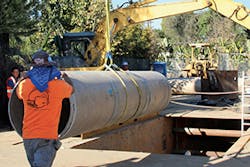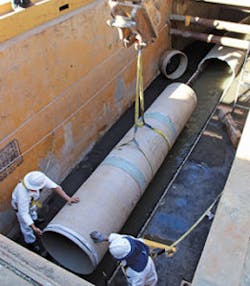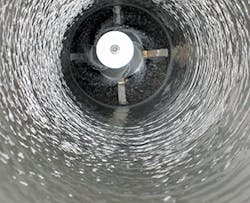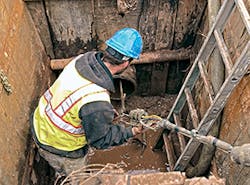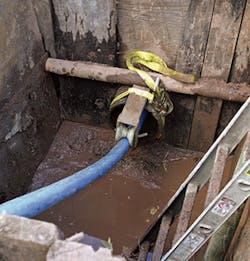More than a million miles of underground pipes carry water to our homes, schools, hospitals, and businesses. These pipes last a long time, but pipes placed during the late 19th century through the middle of the 20th century are nearing—or have already reached—the end of their useful life.
More than a decade ago, the American Water Works Association announced the dawn of the replacement era and the need to rebuild the water and wastewater systems inherited from previous generations. In addition, population growth has increased the demand for water service, placing greater stress on existing pipes and requiring utilities to expand coverage by adding larger pipe networks and repair or refurbish those in use.
The AWWA estimates that the cost will exceed $1.7 trillion through 2050 in order to maintain current levels of water service, with replacement accounting for 54% of the total, and the rest attributed to population growth and migration. Putting it off will only result in poor water service with more disruptions and increasing costs for emergency repairs as pipes fail. The national-level investment facing utilities will roughly double from about $13 billion a year in 2010 to almost $30 billion annually by the 2040s for replacement alone.
The forecast is even more glum when taking into consideration the fact that by the time the last bunch of pipes analyzed in the AWWA’s study (predominantly the pipes laid between the late 1800s and 1960) has been replaced in, for example, 2050, “it may soon thereafter be time to begin replacing the pipes laid after 1960.” In some communities, the infrastructure costs alone could triple the size of a typical family’s water bills.
THEY TRIED TO MAKE ME GO TO REHAB . . .
Because most utilities cannot absorb the exorbitant cost of pipe replacement, many are looking into ways to extend the life of their existing pipes through rehabilitation.
“There is a whole basket of technologies available out there,” says Jake Wells, marketing director for Pipeline Renewal Technologies, Envirosight’s Rehab Unit. He lists CIPP, fold-and-form, slip-lining, grouting, and spray-lining. “The list goes on. Each excels in a specific range of applications.” Because a lot of people wonder which technique best addresses a given set of conditions, they created a poster that illustrates each technique and describes the applications it’s best suited for.
The first thing to determine is the purpose of the rehabilitation. Does the system need structural repair? Does capacity need to be increased? Are there other issues?
Here are some options to consider:
- Chemical grouting stops leaks and reduces soil loss. In this process, self-setting grout is injected into leaking joints or small cracks. The grout spreads outside of the crack or joint to bond with the soil, creating a seal around the leak. It can be successfully performed on pipes 6 inches in diameter and larger.
- Slip-lining involves the insertion of a pipe into an existing pipe. Traditional slip-lining requires digging a lead-in trench for installation. Pipes are welded together before being winched into place. Grouting the space between the lining and the original pipe mitigates infiltration and provides extra strength. Bypass pumping is necessary, which adds to the complexity of this option.
- Fold-and-form pipe repair is a trenchless method in which a new pipe is pulled into the existing pipe and expanded, forming a close fit with the existing pipe.
- Cured-in-place pipe rehab involves the introduction of a polyester flexible sock or sleeve impregnated with resin into the pipe. It is inserted by winch inversion, water inversion, or air inversion. The liner effectively conforms to the pipe’s contours.
- Pipe bursting uses a pneumatic or hydraulic bursting mandrel to crush a pipeline while pulling a new pipe into place. The crushed pipe acts as a structural under-layer for the new pipe.
Setting pipe in a live sewer
CIPP
“For full-line rehabilitation, obviously, CIPP is the most common,” says Wells. It’s the least disruptive to install, minimizes diameter loss, and offers both structural benefits and infiltration abatement. “The trickiest part of CIPP is controlling the cure; an insufficiently cured liner will fail, and replacing a failed liner is costly.”
Envirosight doesn’t manufacture CIPP liners or installation machinery, but they do offer a technology for steam- or hot water-cured CIPP that allows an installer to monitor the temperature continuously along the liner to ensure a proper cure. Without this technology, installers risk either undercooking the liner, or they waste crew time and fuel overcooking it.
When installed correctly, Wells continues, CIPP is very durable, yielding a decades-long service life. Even so, the most vulnerable points of a liner—the ends—can fray with persistent jetter cleaning or high flow with entrained solids. “For this reason, we offer a stainless-steel end cap that installs inside the liner, much like a stent. We think of it as insurance for CIPP. Municipalities spend a lot of money relining their sewer pipes, and this is a low-cost way to make sure the most common mode of failure doesn’t ruin the investment prematurely.”
Lowering short sections into an existing sewer
COATING
Spray-in-place is an option for maintenance and to inhibit corrosion. Scotchkote 2400 is a product from 3M Water Infrastructure that is sprayed inside existing water pipes to address issues arising from corrosive situations, but it also provides some structural enhancement. “It’s not for repairs,” says Kay Gehring, marketing manager. “It won’t fix gaps, but it does provide firm enhancement for pipes.” Scotchkote 2100 is just for corrosion inhibition.
Applied in situations where there’s some leaking or the utility has lost pressure due to tuberculation—the buildup of deposits from corrosion—this prevents corrosion from reforming. Another sign that corrosion is present beyond pressure loss is a red or brown water color. “That indicates corrosion is occurring, due to aging pipes,” Gehring points out.
When a utility has no budget for pipe replacement, this can extend the life of some water pipes. Gehring says it’s most successful when it’s done before there’s an issue.
The “old way” of addressing the issue consisted of putting corrosion protection on pipes before they’re put in the ground, Gehring says, and of using other products to line pipes onsite—but most of those are epoxies that take more time to cure. Another established method is pipe bursting: inserting a new pipe into the old pipe. “This is less invasive.” It’s also less expensive than pipe replacement, although she admits that it’s more expensive than some methods. But installation is definitely easier because you don’t have to dig up the pipe.
Scotchkote Liner 2400 is applied using a spin-cast method.
A 6-foot by 8-foot pit must be dug on each end of the pipe, which is then cleaned and flushed of scale, biofilm, and old linings. Next, Gehring explains, a swab is sent through to remove standing water before an umbilical attached to the rig is threaded through. It has a spray head that spins around, evenly distributing the substance.
An advantage is that it’s fast-curing, Gehring says, adding that “once it cures, water acidity is not an issue.” She says the product lasts an average of 50 years, depending on the conditions, and that it can be used on any type of iron-based pipe: ductile, cast iron, or steel. “It also works on asbestos cement and PVC, but why would you do that?”
The only issue Gehring envisions with this method is insufficient cleaning prior to coating. “Preparation is key,” she notes. The other concern is pipe condition. “We just don’t know the condition of the pipe because it’s been underground for decades.”
SLIP-LINING
“Slip-lining is an excellent solution for rehabilitation of gravity sewer application,” says Jeff LeBlanc, director of Engineering at Thompson Pipe Group – Flowtite. Slip-lining is the installation of new pipe inside an existing, deteriorating pipe. It can also include two-pass tunnel systems, where a casing pipe is microtunneled into place and a carrier pipe is pushed, or “jacked,” into the casing pipe. Then the annular space between the two is grouted.
“By using Flowtite FRP as the carrier pipe, you have the option to jack the pipe in a trenchless application to minimize disruption. Custom diameters allow for maintaining maximum flow capability, and custom joint lengths can reduce the number of installation pits, minimizing installation time.”
Point repair sleeves offer a way to reestablish structural integrity and seal out infiltration. Because they install with a conventional CCTV crawler and require minimal support equipment, they’re ideal for municipalities who want the flexibility and cost savings of performing their own sewer rehab.
Flowtite can be produced in custom diameters that match the inside diameter of existing pipeline, which provides maximum flow capability and allows easy installation. It can be produced in any joint length from 10 feet to 40 feet, which can reduce the number of installation pits required and cut installation time. Additionally, FRP is corrosion-resistant. “Other options can be expensive, more dangerous, or have limitations regarding diameter,” says LeBlanc.
Used on a Los Angeles project in 2016 called North Outfall Sewer Rehabilitation Unit 3 from Vermont Avenue to Trinity Street, Flowtite FRP was chosen because the pipe is known for quality and the custom joint lengths cut down on installation time, LeBlanc explains.
This sewer rehabilitation project for the North Outfall Sewer (NOS) entailed rehabbing 6,780 linear feet of a 90-year old non-round, tile-lined concrete sewer that passed through residential and commercial neighborhoods. The project included having to slip-line curved alignments and had long pushes, LeBlanc adds.
Contractor Spiniello Companies was advised that the concrete sewer was in a semi-elliptical shape, and a 2009 inspection revealed missing tiles in some locations. Because segments of the NOS passed through residential and commercial neighborhoods, flow diversion was not possible at five locations that had to be rehabilitated by man-entry methods.
Advanced process monitoring technologies for heat-cured CIPP installation have helped reduce installation risks and costs, as well as maximize service life and return-on-investment.
Approximately 6,704 feet of existing 72-inch diameter semi-elliptical sewer pipe and 56 feet of existing 63-inch diameter semi-elliptical sewer pipe was rehabilitated by installation of sewer liner. Approximately 21 feet of existing 4-foot-wide by 5.5-foot-high oval sewer and 10 feet of transition pipe were rehabilitated by open excavation.
The work also included cleaning the pipes by removing fallen tiles and other debris, preparation of the NOS interior for liner installation, reconstruction of maintenance holes, and reconnection of various local sewers.
“People and engineers are entertaining the idea of slip-lining pressure sewer and waterlines,” muses LeBlanc. “I believe this is an emerging market because of the limited solutions available. Currently, the market uses cured-in-place liners, but installation time and associated disruption can be extensive. Flowtite FRP has properties that can handle pressure applications while reducing disruption, downtime, and installation time. There would be no need for a bypass. All of this results in cost savings.”
EMERGENCY PROJECT
Slip-lining is an excellent method of rehabilitating sewers since it restores structural strength, prevents future corrosion, stops leaking joints, and provides 50 years of dependable service, says Kimberly Paggioli, vice president of marketing and quality control for HOBAS Pipe USA. “Also, a huge benefit in slip-lining is that the flow in the sewer does not need to be bypass pumped during installation of the liner and generally smaller excavations are needed, compared to a full replacement of the line.”
She discusses an emergency slip-line rehabilitation in Compton, CA. “LACSD has been actively repairing sections of their older system, including sections of Joint Outfall ‘G’ since 2009, with several phases previously rehabbed. During the course of rehabilitation, more urgent areas needing repair were identified and, in many cases, quickly repaired.”
During excavation around the structure, the contractor exposed the 39-inch RCP sewer on the downstream end and found a short section of missing pipe crown. The upstream 39-inch RCP sewer was previously slip-lined with Hobas 33-inch FRP, and the downstream pipe was scheduled to be rehabilitated in the near future. However, after inspection, it was determined that approximately 700 feet of sewer downstream of Manhole 847 was deteriorated and needed urgent repair.
This emergency repair work was completed as a change order to the existing project, stated Derek K. Zondervan, civil engineer, Sewer Design Section for LACSD.
In order to rehabilitate the deteriorated pipe, Hobas supplied 660 feet of 33-inch-diameter flush joint pipe in 20-foot lengths and 60 feet of the same diameter in five-foot lengths. The short pipes were required due to the presence of curves
in the existing line.
The pipe is accessed through a 6-foot by 8-foot pit for cleaning, inspection, and lining.
“The reach included two short radius curves: one with a deflection of approximately four degrees near the downstream end of the 700-foot reach and a second with a deflection of approximately 25 degrees just downstream of Manhole 847 within the insertion pit,” states Zondervan. Five-foot sticks of Hobas pipe were pushed through the four-degree curve and the 25-degree curve was lined by open-cut.
“Slip-lining the existing 39-inch RCP with 33-inch FRP pipe was the preferred option because it avoided the need for a full above-ground flow bypass,” says Zondervan. The capacity of the line post-rehabilitation was still sufficient even though the diameter was decreased. “The daily peak flow in this reach is approximately 10 cfs and the capacity of the 33-inch nominal Hobas FRP after slip-lining is approximately 18 cfs.”
QUICK SOLUTION
Although full-length relining is simple and straightforward, it’s more common for limited budgets and aggressive inflow/infiltration reduction quotas to necessitate point repair—fixing local defects using a targeted approach.
Scotchkote Liner 2400 is attached to an umbilical and pulled back through the pipe.
“Many rehab technologies can be adapted for such needs, but we offer a stainless rehab sleeve that installs without the equipment overhead other technologies demand,” says Wells. The sleeve is positioned within the pipe using a common inspection crawler, whereupon an air bladder expands the sleeve, locking it into position. It has a one-piece rubber gasket that is compressed during installation to seal out infiltration and features a service life comparable with CIPP. “Best of all,” adds Wells, “it’s something municipalities can install themselves to further stretch their maintenance dollars.”
The Quick-Lock point repair sleeve fixes deteriorating and leaky sewer pipes without messy resin, expensive equipment, short working times, or long cures. Designed for unsurpassed service life, Quick-Lock’s stainless-steel construction structurally reinforces deteriorating sewer lines, while its rubber gasket seals out infiltration.
The City of Tallahassee’s Underground Utilities and Public Infrastructure Department chose the Quick-Lock point repair systems for those reasons and because it’s safer, easier, and less disruptive. “Plus, it saves our department money,” exclaims Todd Hacker, superintendent.
Prior to 2014, the Department relied on open-cut excavation methods to perform sewer repair work. This type of excavation often requires a crew to block roadway access as they dig up and replace pipes.
“Open-cut repairs could take up to a whole day, and it was an inconvenience to the public. We needed to find a better way,” says Tony Moore, maintenance construction chief. “With the Quick-Lock, a spot repair now only takes about an hour.”
The Quick-Lock sleeve gives the Department the ability to repair pipes without open-cut excavation. It’s delivered to the repair location on a wheeled flow-through packer pushed by a CCTV crawler. Once in position, air pressure supplied to the packer expands the sleeve tightly against the host pipe wall.
In the past two years, the City of Tallahassee has installed more than 35 Quick-Locks. Moore estimates that the City saved tens of thousands of dollars in fiscal 2016 by performing Quick-Lock point repairs instead of open-cut replacement.
NEW METHODS
UV- and ambient-cure CIPP are gaining popularity because they eliminate some of the process variables that must be controlled when relining—particularly heat via steam or hot water, which is susceptible to the cooling effects of groundwater infiltration. However, Wells says, measurement technologies for heat-cured CIPP have advanced in accuracy and affordability, significantly reducing the variability and risk for these processes.
“Typically, newer types of CIPP don’t require the same amount of pressure as steam or hot water cure, which leaves less of a dimple in the liner to indicate where cuts must be made to reinstate service connections,” continues Wells. Fortunately, cutters are getting smarter; some offer the ability to remember specific coordinates during a pre-lining pass so that no guesswork is required during post-lining reinstatement. Others use radar or similar technologies to sense where laterals lie behind a newly installed liner wall.
Significant amounts of infiltration/inflow (I/I) enter a collection system through the annual gap where a lateral enters a mainline. Processes have emerged to pressure-inject resin into this gap, thereby sealing out infiltration and reestablishing bedding around the joint in cases where infiltration has washed that bedding away. The result is increased system capacity due to reduced I/I, as well as reduced risk from sinkholes and structural failure from washed-out pipe bedding.
Despite the dire predictions by the American Water Works Association about the demands put on an aging infrastructure, new methods and materials are being developed to alleviate the issue of deteriorating pipes. Our water treatment and delivery systems provide critical services, such as public health protection and fire protection, and the convenience and quality of life we enjoy. Yet, cites the AWWA, most Americans pay less than $3.75 for every 1,000 gallons of safe water delivered to their taps. While that bargain may not last, pipe rehabilitation will ensure that utilities are able to continue providing this valuable commodity to residents without interruption.